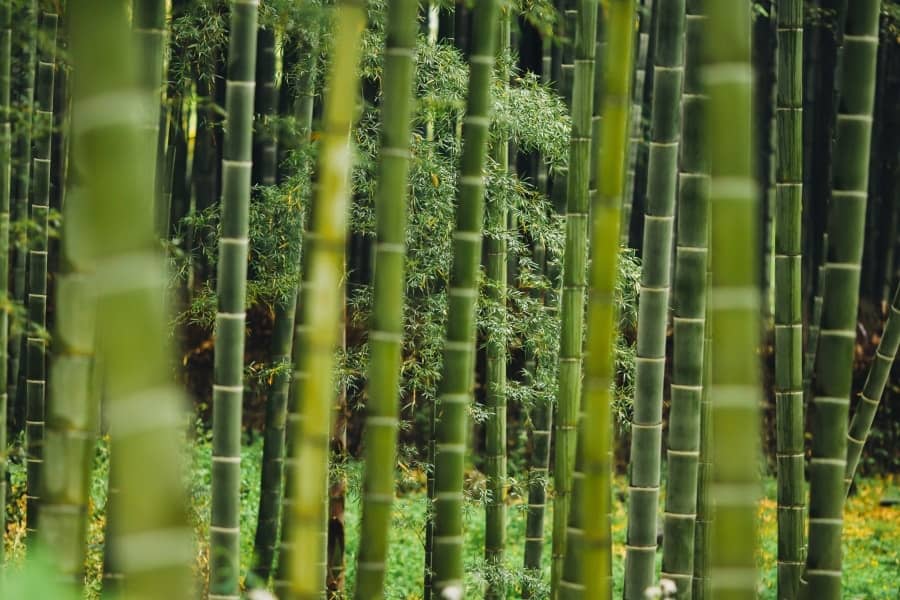Bamboo Products Are Mostly Eco-Friendly
Bamboo has been picking up a lot of attention lately for being an eco-friendly alternative to other types of materials. One of the best characteristics of bamboo is that it’s extremely renewable and sustainable compared to cotton, wood, and similar plants. However, depending on what types of products you buy that are made of bamboo, you could be helping or hurting the environment.
There are a lot of amazing qualities of bamboo that really stand out when compared to other materials:
- Naturally pest resistant, which means no pesticides needed to grow it
- Helps rebuild eroded soil
- Antibacterial
- Anti-fungal
- Requires far less water than similar plants (e.g., cotton)
- Regrows to its adult plant size in 3 to 5 years (it can grow 2 feet in 1 day!)
- Absorbs 5 times more carbon dioxide than similar plants
- Produces 35% more oxygen than similar plants
These are all very impressive, positive qualities of a plant that we hardly use in our everyday life. You’d think we’d have more products in the world using this magical plant so we could leave a better mark on this beautiful green earth. That’s particularly why I use it for a lot of my household items. However, there are some downsides to using bamboo in certain cases.
Apart from the extremely positive reasons to own bamboo products from eco-friendly brands, there are some issues with certain product use-cases. This mainly has to do with converting bamboo into a fabric, which is a process filled with chemicals. If you’ve held bamboo in its natural form, you’d know how hard it can be. Well, to reduce that down to a soft fabric to compete with the likes of cotton can be a problem.
Chemically processed bamboo that’s converted to fabric usually comes in the form of viscose rayon. To produce bamboo fabric, the material must go through an intense chemical process involving the use of harsh chemicals such as sulfuric acid and sodium hydroxide. Not exactly eco-friendly if you ask me.
As a matter of fact, the use of these chemicals is extremely harmful to the environment and people in general. Not only do they negatively affect the quality of the once-natural material, but chemical runoff from whoever manufactured the fabric is detrimental to local environments. This is a big no-no.
When it comes to bamboo products that are still in solid form, you’re almost guaranteed to have a sustainable, eco-friendly product. Think bamboo serving trays, cups, bowls, utensils, containers, and almost anything else around the house. However, when considering purchasing bamboo fabric, like towels, blankets, and clothes, you should check to see if the manufacturer is green and avoids the use of harsh chemicals. This can be tricky based on my experience, so I decided to simply avoid purchasing any bamboo fabric.
Bamboo Fabrics That Are (Kind Of) Eco-Friendly
If you’re in the market for some bamboo clothes, towels, or any other fabric-like product, there is an option that’s considered fairly eco-friendly. Remember, when
Lyocell is normally made from eucalyptus plants, but it can also be made from bamboo. The reason for this is the materials are very similar to one another. The greatest quality of producing bamboo lyocell is that it’s a 100% closed-loop cycle, which ensures that all the chemicals, water, and everything else used to produce it is 100% recycled and contained. This means no leakage of bad agents into the environment.
Now you may have heard of Tencel, which is almost exactly the same as bamboo lyocell. In actuality, Tencel is a brand and looks, feels, and acts almost 100% like bamboo lyocell, but with some small differences. While they’re processed almost exactly the same, Tencel can contain a mix of other fabrics, like cotton and viscose rayon, and it can be about 20% to 30% more expensive when compared to other bamboo lyocell products. That means it’s potentially less Eco-friendly due to the combination of mixed fabrics and it costs more in general.
Using bamboo lyocell is definitely a much more eco-friendly way to spruce up your house with bamboo fabric. As a matter of fact, bamboo is a very absorbent material when converted into fabric form, making bamboo lyocell an even better candidate than other similar materials.
Bamboo Is Super Strong
Using bamboo is not only overall environmentally friendly, but it’s also one of the strongest materials on the planet. The amount of material needed to produce a sturdy product can be much less when compared to other materials such as wood. So next time you drop a plate or bang your tray against the wall, likely bamboo will be able to handle the hit.
Bamboo has a strong, natural fiber that has shown to be superior to similar materials, especially wood. It has an amazing quality that allows it to be very flexible due to its naturally long fibers, so it doesn’t break as easily as wood when bending it to form into various shapes. This can be beneficial because then all kinds of products can be made, which wouldn’t be possible with other similar materials. As a matter of fact, bamboo and hemp share similar qualities when it comes to tensile strength.
In less developed countries, entire houses, buildings, bridges, and boats have been constructed solely out of bamboo. This is massively productive because bamboo is not only very strong, but it is less prone to warping and general damage due to water. This means that when covered in water, whether from a river or rain, it can withstand it. What can this magical plant not do?
Where Does Bamboo Come From?
Clearly, bamboo is a very Eco-friendly solution to all types of scenarios when it comes to household items and construction purposes. Ideally, this plant would be growing all over the place so everyone could have the chance to use it in their local setting. However, most bamboo is produced in a small number of countries, thus it needs to be transported globally.
Several regions around the world produce bamboo, including Southeast Asia, Central and South America, and Africa. However, the largest producer of bamboo is certainly China, which should come to no surprise. Their pandas need to eat something! Don’t worry, they still have a lot to eat.
The thing is, China is the only country in the world that has enough bamboo to produce it at mass scale. While bamboo has always been a staple material for China, over the years it’s become much more popular due to its commercial success. This has created a lot of factories around the region that produce all kinds of bamboo products and has been a cash crop for many years now.
There are issues with such grand scale of bamboo products being produced. For one, farmers are incentivized to plant more and more bamboo trees even in areas that may not be suitable for them to grow, which encourages over fertilization to continue the increasing supply of bamboo products. Also, since bamboo has become such a profitable plant, farmers are starting to clear natural forestland to plant even more bamboo.
While bamboo is overall a very Eco-friendly product, it would be beneficial for the environment if it were to grow in many places around the world. It would be great if countries were encouraged to grow some in their local communities.
Related Questions
Can I recycle bamboo products? You can recycle bamboo products that aren’t chemically processed (e.g., fabrics). Bamboo is naturally biodegradable and, therefore, can be used in compost for use in gardens and other natural settings.
Is bamboo more sustainable than cotton? Bamboo is more sustainable than cotton because, among other things, it doesn’t require the use of a huge amount of chemicals, it’s 100% biodegradable, it’s naturally pest resistant, and it’s highly renewable.
Source: https://householdwonders.com/are-bamboo-products-eco-friendly/


Recent Comments